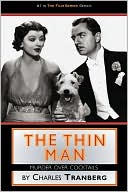Review: Another Thin Man (1939)
>> Monday, January 28, 2008

The announcement of Nora’s pregnancy at the end of After the Thin Man (1936) sounded the death knell for the carefree, drunken revelry that was a hallmark of the first two films in the popular MGM Thin Man series. It would have been irresponsible to portray sleuthing socialites Nick and Nora Charles as bleary-eyed souses with Nick Jr. to care for (even if the pair could afford a full-time nurse). Consequently, the boozing was toned down tremendously in Another Thin Man. This time around, Nora doesn’t down a drop; and although Nick hits the bottle whenever he gets the chance, those chances are strung so far apart that he never manages to get drunk. Despite the lessened alky content, Another Thin Man still manages to be a worthy series entry. Being that the film re-teams William Powell, Myrna Loy, and Asta with the director and writers of the first two Thin Man films, much of the magic of the earlier movies remains. The dialogue is still wonderfully witty; the mystery is still bafflingly complex; and the set is populated by the finest character actors in Hollywood (including everyone from Marjorie Main to Shemp Howard). Most importantly, although Powell and Loy had solidly hit middle age, their chemistry was still electric and surprisingly sexy.
Despite the lessened alky content, Another Thin Man still manages to be a worthy series entry. Being that the film re-teams William Powell, Myrna Loy, and Asta with the director and writers of the first two Thin Man films, much of the magic of the earlier movies remains. The dialogue is still wonderfully witty; the mystery is still bafflingly complex; and the set is populated by the finest character actors in Hollywood (including everyone from Marjorie Main to Shemp Howard). Most importantly, although Powell and Loy had solidly hit middle age, their chemistry was still electric and surprisingly sexy.
The mystery begins when Nick and Nora receive a call from Colonel MacFay (C. Aubrey Smith), an old friend of Nora’s father who manages her financial interests. He insists that the couple join him for the weekend under the pretense of discussing business, but when Nick and Nora arrive at his estate, they discover that MacFay’s life has been threatened by an ex-con (Sheldon Leonard). Of course, that leads to multiple murders and to Nick being recruited once again to reluctantly play detective. Worse yet, the Colonel keeps his liquor cabinet locked.
Three films in, the Thin Man series isn’t nearly as intoxicating as it once was in terms of booze. However, the films are still unmatched in terms of fun.
Drinks Consumed--Scotch, rum, and unnamed liquor
Intoxicating Effects--Sneaking sips
Potent Quotables--NORA: I got rid of all those reporters.
NICK: What’d ya tell them?
NORA: I told them we were out of scotch.
NICK: What a gruesome thought.
Video Availability--Another Thin Man is available as a solo DVD or as part of The Complete Thin Man Collection (The Thin Man / After the Thin Man / Another Thin Man / Shadow of the Thin Man / The Thin Man Goes Home / Song of the Thin Man).
Similarly Sauced Cinema--Nick and Nora next appeared in Shadow of the Thin Man (1941).













































